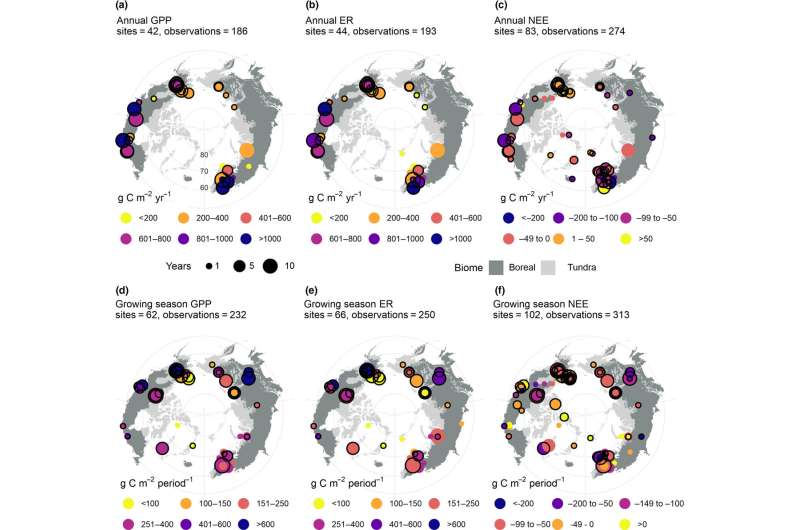Scientists use novel methods to examine movement of carbon in northern terrestrial ecosystems

A new study, published in Global Change Biology, employs novel methodological advances to examine the movement of carbon dioxide (CO2) in and out of northern terrestrial ecosystems and identify the CO2 uptake and release patterns across different regions. Because northern permafrost regions store around half of global soil organic carbon, which is vulnerable to decomposition and emission to the atmosphere with climate warming, improving understanding of high-latitude region carbon fluctuations is essential to tracking global carbon budgets and mitigating the impacts of climate change.
The study took an unprecedented approach to evaluating carbon fluxes in boreal and tundra regions, synthesizing data from 148 sites using a combination of commonly-used statistical and machine learning models, and remote sensing and geospatial data to analyze the patterns and drivers of ecosystem CO2 "sinks" (net removal of CO2 from the atmosphere) and CO2 "sources" (net release of CO2 into the atmosphere). The results indicate that Fennoscandia, European Russia, southern Canada, and southern Siberia were all found to be annual carbon dioxide sinks, while northern and central Siberia, northern and central Alaska, and northern Canada were all found to be annual sources, revealing nuance and variability not only between regions but also within. On average, both boreal and tundra biomes continue to act as CO2 sinks, although the tundra was found to be a less-effective sink than some previous studies have shown—a result that could indicate a potential shift in carbon movement through our ecosystems as a result of climate change and permafrost thaw.
"There remains a lot of uncertainty in large-scale carbon dioxide flux synthesis and modeling, but the fact that the boreal region is a strong carbon dioxide sink, while the tundra biome is closer to carbon dioxide neutral gives us valuable insight into carbon balance in the region," said Woodwell Climate scientist, former Ph.D. student at the University of Helsinki, and lead author of the report, Dr. Anna Virkkala. "It tells us that the plant carbon uptake in the tundra is barely keeping up with the carbon dioxide emissions associated with, for example, permafrost thaw, and we need to keep monitoring how these carbon budgets change over the next several decades."
"As the climate warms, we are seeing permafrost thawing along with more wildfire and other disturbances," said Woodwell Climate scientist and report co-author Dr. Brendan Rogers. "The data from this work show that, right now, undisturbed boreal forests and boreal wetlands continue to sequester carbon dioxide that is emitted into the atmosphere every year due to human activities. The concern is that ultimately these positive feedback loops will cause areas that have historically served as carbon sinks to become carbon sources. Just because a region is serving as a sink now doesn't mean it will serve as one 30 years from now."
"The methods we developed for this study are a strong step toward creating better predictions of carbon dioxide fluxes," said Miska Luoto, a professor in physical geography at the University of Helsinki. "However, as a result of large environmental and geographical gaps, it remains a challenge to account for variability due to factors such as fire and logging—which function to decrease the net carbon dioxide sink, and would likely have an impact on study results. While our methods lay the foundation, it will be essential to continue our research in order to most accurately and effectively understand movement of carbon in the region, and its implications, on changing climate."
The study, co-authored by Woodwell Climate's Dr. Virkkala, Dr. Rogers, Dr. Sue Natali, Dr. Watts, and Potter, along with 44 scientists from institutions around the globe, takes an important step toward better understanding regional and global carbon balances, and the accuracy and effectiveness of the tools and methods available to measure them. To build on this work and support future studies, Woodwell's team plans to release an updated carbon dioxide flux database with improved geographic and seasonal coverage in order to develop improved models of CO2 fluxes and monitor key changes and their implications across the high latitudes.
More information: Anna‐Maria Virkkala et al, Statistical upscaling of ecosystem CO 2 fluxes across the terrestrial tundra and boreal domain: Regional patterns and uncertainties, Global Change Biology (2021). DOI: 10.1111/gcb.15659
Journal information: Global Change Biology
Provided by University of Helsinki




















